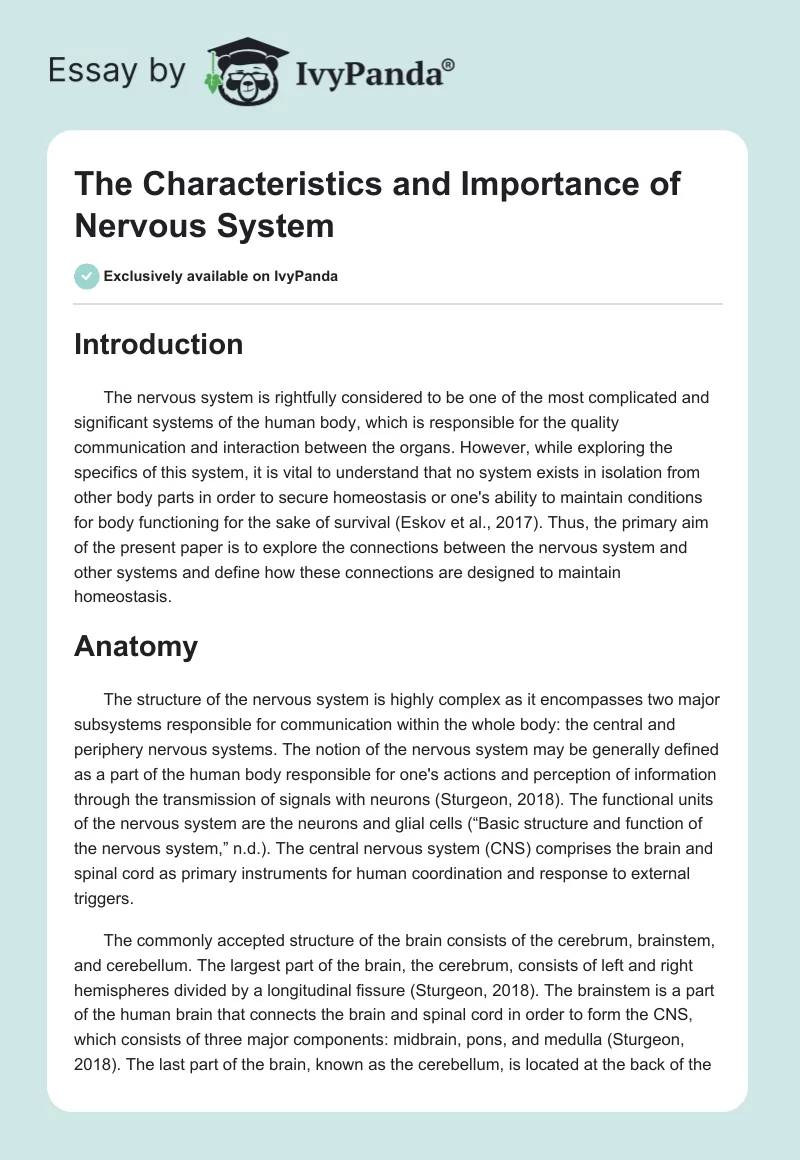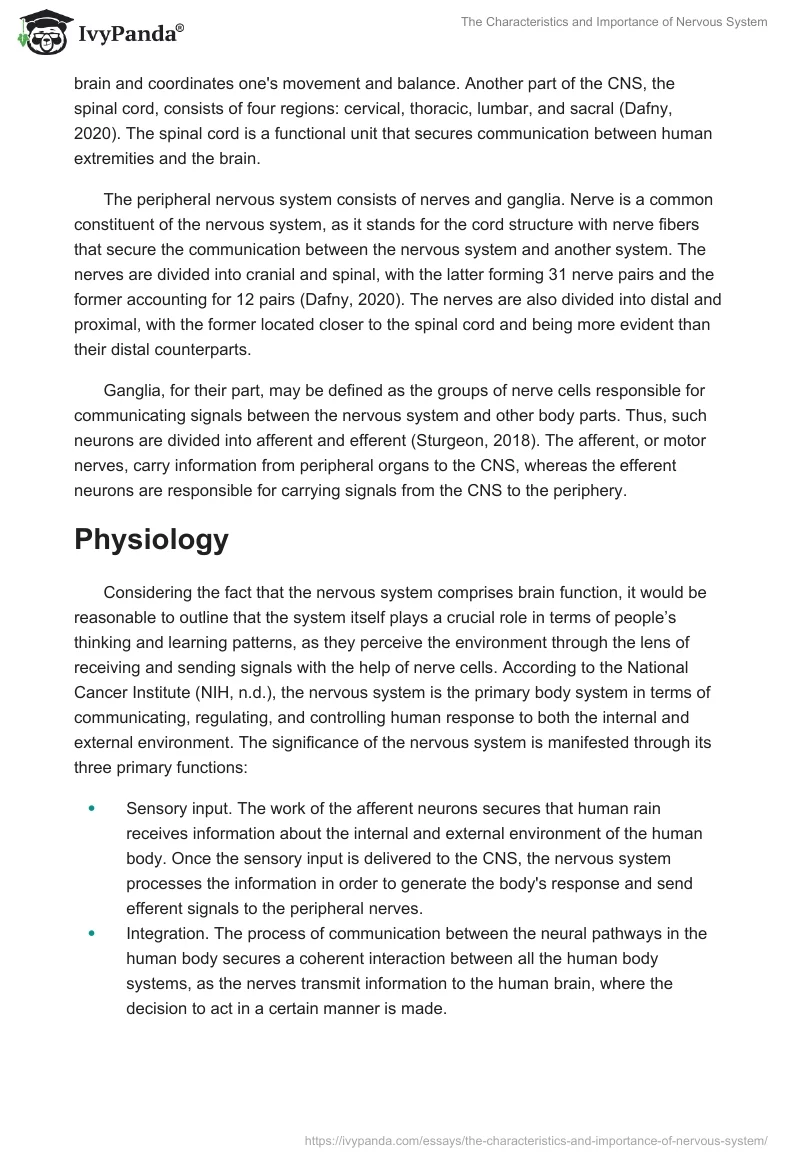Introduction
The nervous system is rightfully considered to be one of the most complicated and significant systems of the human body, which is responsible for the quality communication and interaction between the organs. However, while exploring the specifics of this system, it is vital to understand that no system exists in isolation from other body parts in order to secure homeostasis or one’s ability to maintain conditions for body functioning for the sake of survival (Eskov et al., 2017). Thus, the primary aim of the present paper is to explore the connections between the nervous system and other systems and define how these connections are designed to maintain homeostasis.
Anatomy
The structure of the nervous system is highly complex as it encompasses two major subsystems responsible for communication within the whole body: the central and periphery nervous systems. The notion of the nervous system may be generally defined as a part of the human body responsible for one’s actions and perception of information through the transmission of signals with neurons (Sturgeon, 2018). The functional units of the nervous system are the neurons and glial cells (“Basic structure and function of the nervous system,” n.d.). The central nervous system (CNS) comprises the brain and spinal cord as primary instruments for human coordination and response to external triggers.
The commonly accepted structure of the brain consists of the cerebrum, brainstem, and cerebellum. The largest part of the brain, the cerebrum, consists of left and right hemispheres divided by a longitudinal fissure (Sturgeon, 2018). The brainstem is a part of the human brain that connects the brain and spinal cord in order to form the CNS, which consists of three major components: midbrain, pons, and medulla (Sturgeon, 2018). The last part of the brain, known as the cerebellum, is located at the back of the brain and coordinates one’s movement and balance. Another part of the CNS, the spinal cord, consists of four regions: cervical, thoracic, lumbar, and sacral (Dafny, 2020). The spinal cord is a functional unit that secures communication between human extremities and the brain.
The peripheral nervous system consists of nerves and ganglia. Nerve is a common constituent of the nervous system, as it stands for the cord structure with nerve fibers that secure the communication between the nervous system and another system. The nerves are divided into cranial and spinal, with the latter forming 31 nerve pairs and the former accounting for 12 pairs (Dafny, 2020). The nerves are also divided into distal and proximal, with the former located closer to the spinal cord and being more evident than their distal counterparts.
Ganglia, for their part, may be defined as the groups of nerve cells responsible for communicating signals between the nervous system and other body parts. Thus, such neurons are divided into afferent and efferent (Sturgeon, 2018). The afferent, or motor nerves, carry information from peripheral organs to the CNS, whereas the efferent neurons are responsible for carrying signals from the CNS to the periphery.
Physiology
Considering the fact that the nervous system comprises brain function, it would be reasonable to outline that the system itself plays a crucial role in terms of people’s thinking and learning patterns, as they perceive the environment through the lens of receiving and sending signals with the help of nerve cells. According to the National Cancer Institute (NIH, n.d.), the nervous system is the primary body system in terms of communicating, regulating, and controlling human response to both the internal and external environment. The significance of the nervous system is manifested through its three primary functions:
- Sensory input. The work of the afferent neurons secures that human rain receives information about the internal and external environment of the human body. Once the sensory input is delivered to the CNS, the nervous system processes the information in order to generate the body’s response and send efferent signals to the peripheral nerves.
- Integration. The process of communication between the neural pathways in the human body secures a coherent interaction between all the human body systems, as the nerves transmit information to the human brain, where the decision to act in a certain manner is made.
- Motor response. This function of the nervous system allows for the human’s reaction to the signals entering the nervous system through neural pathways (“Introduction to the nervous system,” n.d.).
- Social homeostasis. Over the past years, researchers ponder the relevance of humans’ social response to the environment with the help of neural patterns. According to Matthews and Tye (2019), similarly to the conventional nervous system defining the person’s energy and fluid needs, neural systems may generate afferent signals requiring social interactions and other endeavors in order to preserve the social homeostasis of an individual.
Homeostasis
Endocrine System
The endocrine system is considered the most closely related to the nervous system due to the fact that while the latter regulates natural human response to various factors, the former stimulates and controls the inner body development through the release of hormones into the brain. The two systems are linked with the help of the hypothalamus, an organ that receives the information from the automatic nervous system regarding the body’s internal balance and hormonal state (Sturgeon, 2018). The motor response generated by the nervous system is highly dependent on the person’s ability to produce reactions on the behavioral level, which depends on the release of such hormones as epinephrine and norepinephrine. The nervous system is able to control the release of hormones with the help of pituitary glands attached to the hypothalamus, and such control plays a dramatic role in the person’s growth, behavioral patterns, and even sexuality and reproductive health. For this reason, it may be concluded that the interrelation between the nervous and endocrine systems is vital for the development of a proper human response to the external world and internal growth.
Skeletal System
The skeletal system, which stands for the bone framework of the human body that moves with the help of muscle contractions, exists in symbiosis with the nervous system. First, the skeleton system provides the nervous system with protection from injuries. For example, the skull and vertebrae protect the brain and spinal cord from potential injuries. Second, bones store calcium vital for the functioning of nerve cells. As far as benefits for the skeletal system are concerned, the nervous system provides positional information to the brain, protecting the bones from improper positioning of bones and joints.
Muscular System
The muscular system of the human body, which is mostly comprised of various types of muscles, serves as a means of motion of the human body and process within it, including digestion (Sturgeon, 2018). The neural signals make muscles contract, as the muscles attached to the bones execute the movement pattern programmed by the brain. Moreover, the nervous system also receives information concerning external factors such as temperature, making the muscles adjust the body heat according to the environment. Finally, the nervous system has the ability to regulate the speed with which the food should go through the digestive tract (Rubin, 2020). Hence, the cooperation between these two systems secures the initiation of such vital processes and nutrient digestion and motion.
Cardiovascular and Lymphatic Systems
These two systems are highly dependent on the proper functioning of the nervous system, as they are responsible for the fluid circulation within the body, including blood, oxygen, and lymph fluid. The nervous system accounts for the regulation of heart rate and blood pressure by employing a vagus nerve. The nervous system also obtains a specific neural receptor called baroreceptor, which is responsible for signaling information about blood pressure to the brain in order for it to make necessary adjustments. Endothelial cells that belong to a circulatory system aim at maintaining the blood-brain barrier that prevents the CNS from the invasion of toxic pathogens. Hence, it may be concluded that both circulatory and lymphatic systems cannot exist without the nervous system, as the brain that receives afferent neurons is in charge of transmitting the fluids across the body.
Digestive System
The patterns of digestion depend explicitly on the nervous system, as the brain is responsible for the human’s eating and drinking behavior regarding one’s environment. The brain receives information from the digestive system through the neural pathways, making people eat and drink. Moreover, it was mentioned previously that the coordination of nervous and muscular systems regulates the pace of food through the digestive tract. The digestive processes provide a foundation for the proper functioning of neurotransmitters, as nutrition contributes to the transmission of hormones.
Respiratory and Reproductive Systems
The respiratory system that accounts for the circulation of oxygen and carbon dioxide within the body is also highly dependent on the nervous system. The nervous system consists of respiratory neurons that signal the respiratory muscles in order to circulate air. The reproductive system, for its part, impacts the brain’s development and behavioral patterns through the release of reproductive hormones. The system itself is affected because the brain is responsible for the overall sexual behavior of the individual. Thus, with the help of the nervous system, the reproductive organs communicate to the brain their readiness to mate and reproduce.
Urinary and Integumentary Systems
The urinary system, comprising the bladder, urethra, and kidney, is co-dependent with the nervous system, as waste elimination is performed through channeling the signals to the brain. The integumentary system, for its part, encompasses such body parts as skin and hair, and they play a significant role in the functioning of the nervous system, as skin is a major external receptor that renders the information concerning one’s environment. In its turn, the nervous system regulates the growth and condition of hair and skin regarding the inner state of the human body, hormonal, and vitamin balance.
Conclusion
The nervous system is a highly complex combination of body parts that exist in cooperation with each other in order to control and regulate human movement and behavior. However, while the nervous system obtains a variety of autonomous features, it cannot exist in isolation from all the other body systems. The process of discovering interconnections between the nervous system and the other systems has shown that the proper functioning of the nervous system requires interaction with every single part of the human body.
References
Basic structure and function of the nervous system. (n.d.). Lumen Learning. Web.
Eskov, V. M., Filatova, O. E., Eskov, V. V., & Gavrilenko, T. V. (2017). The evolution of the idea of homeostasis: Determinism, stochastics, and chaos–self-organization. Biophysics, 62(5), 809-820.
Introduction to the nervous system. (n.d.). Lumen Learning. Web.
Matthews, G. A., & Tye, K. M. (2019). Neural mechanisms of social homeostasis.Annals of the New York Academy of Sciences, 1457(1), 5–25.
Rubin, N. (2020). Overview of the peripheral nervous system.
Sturgeon, D. (2018). Introduction to anatomy and physiology for healthcare students. Routledge.


